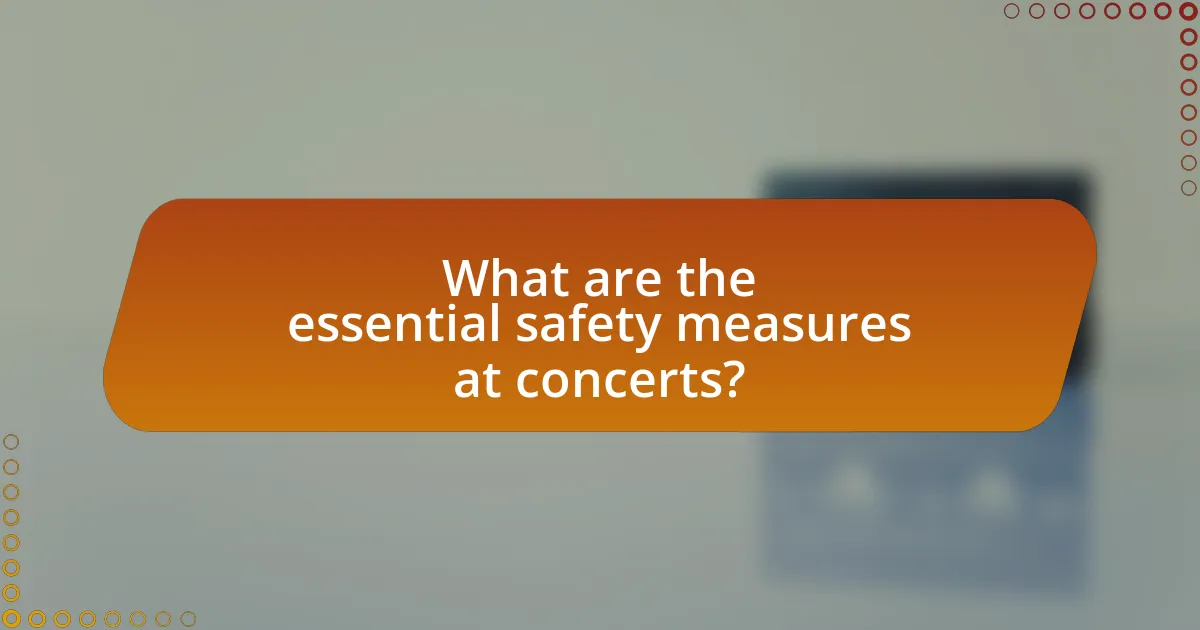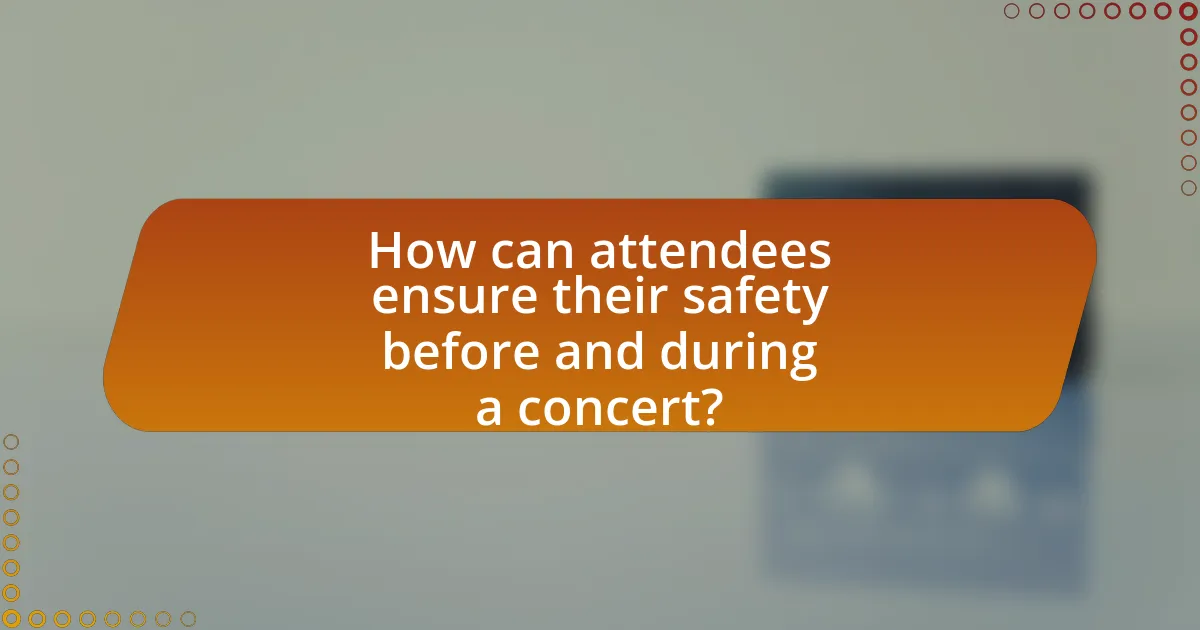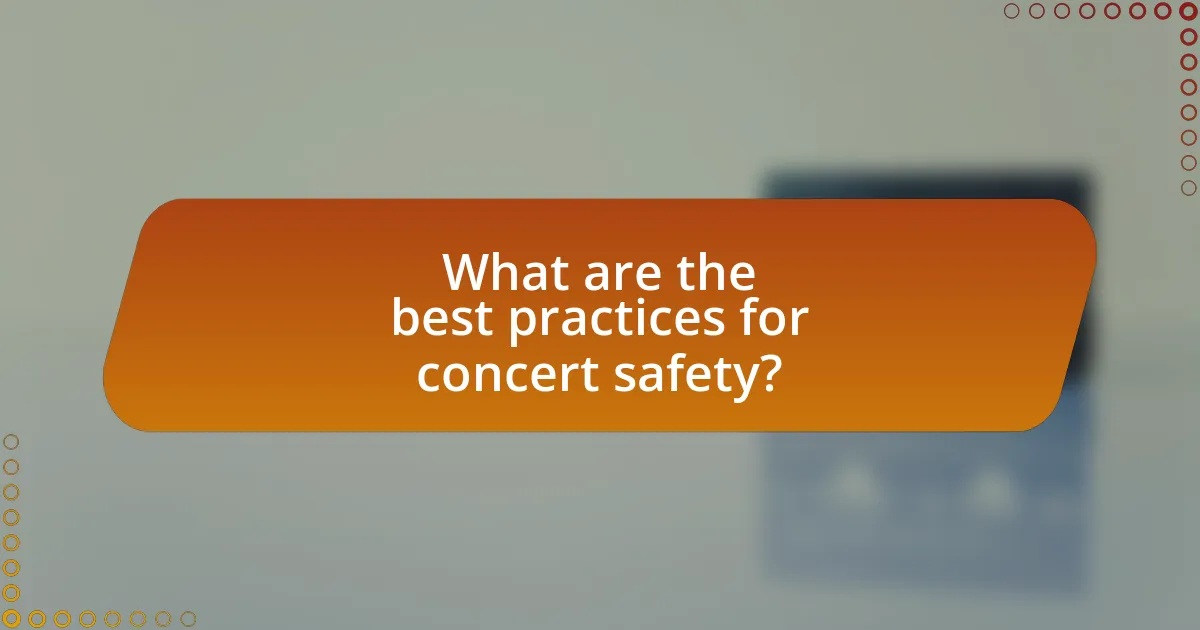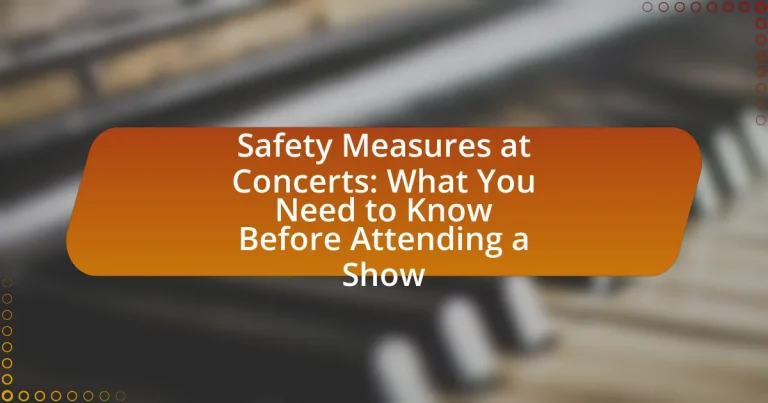The article focuses on essential safety measures at concerts, emphasizing the importance of crowd management, emergency exits, and security checks to protect attendees from potential hazards. It outlines the risks associated with attending live music events, including physical injuries, health concerns, and security threats, and discusses how effective safety protocols can mitigate these risks. Additionally, the article provides practical tips for concert-goers on personal safety, emergency preparedness, and communication strategies to enhance their overall experience while ensuring their well-being at large gatherings.

What are the essential safety measures at concerts?
Essential safety measures at concerts include crowd management, emergency exits, and security checks. Crowd management ensures that attendees are organized and safe, reducing the risk of injuries during large gatherings. Emergency exits must be clearly marked and accessible to facilitate quick evacuation in case of an emergency. Security checks, including bag inspections and metal detectors, help prevent dangerous items from entering the venue, enhancing overall safety. These measures are critical in minimizing risks and ensuring a secure environment for concertgoers.
Why is safety important at live music events?
Safety is crucial at live music events to protect attendees from potential hazards such as crowd surges, fire, and other emergencies. Ensuring safety measures are in place minimizes the risk of injuries and fatalities, as evidenced by incidents like the 2017 Las Vegas shooting, which highlighted the need for effective security protocols. Additionally, according to a report by the National Fire Protection Association, proper crowd management and emergency response plans can significantly reduce the likelihood of chaos during unforeseen situations. Thus, prioritizing safety at live music events is essential for safeguarding the well-being of all participants.
What risks are associated with attending concerts?
Attending concerts poses several risks, including physical injuries, health concerns, and security threats. Physical injuries can occur due to crowd surges, falls, or accidents involving equipment, with reports indicating that over 1,000 concert-goers are injured annually in the U.S. alone. Health concerns include exposure to loud noise levels, which can lead to hearing damage, as studies show that sounds above 85 decibels can cause permanent hearing loss. Additionally, security threats such as violence or terrorism have been documented, with incidents like the 2017 Las Vegas shooting highlighting the potential dangers at large events. These risks necessitate awareness and precautionary measures for concert attendees.
How can safety measures mitigate these risks?
Safety measures can mitigate risks at concerts by implementing crowd control strategies, emergency response plans, and health protocols. For instance, effective crowd management reduces the likelihood of stampedes and injuries, as evidenced by the use of barriers and trained personnel to guide attendees. Additionally, having a clear emergency response plan ensures quick action during incidents, which can significantly lower the impact of emergencies. Health protocols, such as sanitation stations and health screenings, help prevent the spread of illnesses, thereby protecting attendees’ well-being. These measures collectively create a safer environment, reducing the potential for harm during large gatherings.
What types of safety measures are commonly implemented?
Commonly implemented safety measures at concerts include crowd control, emergency medical services, and security personnel presence. Crowd control measures often involve barriers and designated entry and exit points to manage the flow of attendees, reducing the risk of overcrowding and potential injuries. Emergency medical services are typically on-site to provide immediate assistance in case of health emergencies, ensuring quick response times. Additionally, the presence of trained security personnel helps to monitor the audience, enforce rules, and address any disturbances, contributing to a safer environment for all attendees. These measures are standard practices in the event industry to enhance safety and minimize risks during large gatherings.
What role do security personnel play in concert safety?
Security personnel are essential for ensuring concert safety by managing crowd control, preventing unauthorized access, and responding to emergencies. They monitor the venue for potential threats, enforce safety protocols, and assist in the evacuation process if necessary. Their presence deters unruly behavior and helps maintain a secure environment for attendees. According to the International Association of Venue Managers, effective security measures at events significantly reduce incidents of violence and disorder, highlighting the critical role security personnel play in safeguarding concertgoers.
How do venue regulations contribute to safety?
Venue regulations contribute to safety by establishing standards that ensure the structural integrity, crowd management, and emergency preparedness of event spaces. These regulations mandate features such as fire exits, occupancy limits, and safety equipment, which are crucial for preventing accidents and facilitating quick evacuations during emergencies. For instance, the National Fire Protection Association (NFPA) outlines specific codes that venues must follow to minimize fire hazards, thereby enhancing overall safety for attendees.
What should attendees know about personal safety at concerts?
Attendees should know to remain aware of their surroundings and have a plan for emergencies at concerts. Personal safety can be enhanced by staying with friends, knowing the venue layout, and identifying exits. According to the National Safety Council, being aware of potential hazards and having a communication plan can significantly reduce risks in crowded environments. Additionally, attendees should avoid excessive alcohol consumption and be cautious of personal belongings to prevent theft or loss.
How can concert-goers prepare for potential emergencies?
Concert-goers can prepare for potential emergencies by familiarizing themselves with the venue’s emergency exits and procedures. Knowing the layout of the venue allows attendees to quickly locate exits in case of an emergency, which is crucial for safety. Additionally, concert-goers should keep their mobile phones charged and have a plan for communication with friends or family in case they become separated. According to the National Fire Protection Association, understanding emergency protocols can significantly reduce panic and improve response times during critical situations.
What personal items should be avoided for safety reasons?
Personal items that should be avoided for safety reasons at concerts include large bags, professional cameras, and any type of weapon. Large bags can obstruct pathways and create hazards during emergencies, while professional cameras may be prohibited to prevent disruption and ensure the safety of attendees. Weapons, including knives and firearms, pose significant risks and are typically banned at venues to protect the safety of all participants. These restrictions are enforced by most concert venues and event organizers to maintain a secure environment for everyone.

How can attendees ensure their safety before and during a concert?
Attendees can ensure their safety before and during a concert by planning ahead, staying aware of their surroundings, and following venue guidelines. Prior to the event, individuals should familiarize themselves with the venue layout, including emergency exits and first aid stations, which enhances their ability to respond in case of an emergency. During the concert, maintaining situational awareness helps attendees identify potential hazards, such as overcrowding or aggressive behavior. Additionally, adhering to the venue’s safety protocols, such as bag checks and security measures, contributes to a safer environment. Statistics show that venues with clear safety procedures and trained staff significantly reduce incidents, underscoring the importance of these measures for attendee safety.
What steps should be taken before attending a concert?
Before attending a concert, individuals should purchase tickets in advance, verify the venue’s safety protocols, and plan transportation. Purchasing tickets ensures entry, while checking safety protocols, such as bag checks and health guidelines, helps mitigate risks. Planning transportation, whether by public transit or rideshare, ensures timely arrival and reduces parking-related stress. These steps are essential for a safe and enjoyable concert experience.
How can attendees research venue safety protocols?
Attendees can research venue safety protocols by visiting the official website of the venue, where safety measures are typically outlined. Many venues provide detailed information regarding emergency procedures, health guidelines, and security measures in place for events. Additionally, attendees can check social media platforms and event pages for updates or announcements related to safety protocols. Reviews and feedback from previous attendees can also offer insights into the effectiveness of these measures.
What should be considered when choosing a concert to attend?
When choosing a concert to attend, individuals should consider the venue’s safety measures, including crowd control protocols and emergency exit accessibility. Research indicates that venues with well-defined safety plans, such as those outlined by the National Fire Protection Association, significantly reduce risks during large gatherings. Additionally, attendees should evaluate the artist’s reputation for safety and the overall security presence at the event, as these factors contribute to a safer concert experience.
What actions can be taken during the concert for personal safety?
To ensure personal safety during a concert, individuals should remain aware of their surroundings and identify emergency exits. Staying alert helps in recognizing potential hazards, such as overcrowding or aggressive behavior from other attendees. Additionally, keeping personal belongings secure and avoiding excessive alcohol consumption can reduce risks. According to the National Safety Council, being mindful of one’s environment significantly decreases the likelihood of accidents or altercations in crowded venues.
How can attendees stay aware of their surroundings?
Attendees can stay aware of their surroundings by actively observing their environment and remaining alert to changes. This includes scanning the crowd for unusual behavior, listening for announcements or warnings, and being mindful of exits and emergency procedures. Research indicates that heightened situational awareness can significantly reduce risks in crowded venues, as individuals who are attentive are better equipped to respond to potential hazards or emergencies.
What should be done in case of an emergency situation?
In case of an emergency situation at a concert, individuals should immediately follow the venue’s emergency protocols, which typically include evacuating the area calmly and quickly. Emergency exits are usually marked and should be used to exit the venue safely. Additionally, attendees should remain aware of their surroundings and listen for announcements from event staff or security personnel, who are trained to manage emergencies effectively. Following these steps can significantly enhance personal safety and the safety of others during an emergency.

What are the best practices for concert safety?
The best practices for concert safety include being aware of your surroundings, following venue rules, and having an emergency plan. Attendees should familiarize themselves with the venue layout, including exits and first aid stations, to ensure quick access in case of an emergency. Following the venue’s safety protocols, such as not crowd surfing or engaging in mosh pits, can prevent injuries. Additionally, having a designated meeting spot for friends in case of separation enhances safety. According to the National Safety Council, being prepared and informed significantly reduces risks during large gatherings.
How can attendees communicate safety concerns effectively?
Attendees can communicate safety concerns effectively by using designated communication channels provided by event organizers, such as emergency hotlines or text messaging systems. These channels are often monitored by security personnel who can respond quickly to reported issues. For instance, many large venues implement a text-to-report system that allows attendees to discreetly report safety concerns without drawing attention to themselves, ensuring that issues are addressed promptly. This method has been shown to improve response times and enhance overall safety during events.
What should be reported to security personnel?
Any suspicious behavior, potential threats, or safety hazards should be reported to security personnel. This includes individuals acting unusually, unattended bags or items, or any signs of violence or aggression. Reporting these incidents helps maintain a safe environment for all attendees, as security personnel are trained to assess and respond to such situations effectively.
How can friends help each other stay safe at concerts?
Friends can help each other stay safe at concerts by establishing a meeting point and maintaining communication throughout the event. This ensures that if anyone gets separated, they can easily find each other. Additionally, friends should look out for one another by monitoring each other’s alcohol consumption and being aware of their surroundings to avoid potential hazards, such as overcrowding or aggressive behavior from other attendees. Studies show that having a buddy system significantly reduces risks in crowded environments, as it promotes vigilance and support among friends.
What are some common misconceptions about concert safety?
Common misconceptions about concert safety include the belief that large venues are inherently unsafe and that security measures are excessive. Many people assume that the size of a venue correlates directly with danger; however, statistics show that well-managed large events often have lower incident rates due to comprehensive safety protocols. Additionally, some attendees view security checks as intrusive rather than necessary; in reality, these measures, such as bag checks and metal detectors, are implemented to prevent potential threats and ensure a safe environment. According to a report by the National Association of Ticket Brokers, incidents at concerts are rare, with safety measures significantly reducing risks.
Why do some people underestimate the importance of safety measures?
Some people underestimate the importance of safety measures due to a lack of awareness about potential risks and a tendency to prioritize enjoyment over precaution. This mindset can lead to complacency, where individuals believe that accidents are unlikely to happen, despite statistics indicating that safety incidents can occur at events like concerts. For instance, a report from the National Safety Council highlights that crowd-related incidents can lead to serious injuries or fatalities, emphasizing the need for effective safety protocols.
How can misinformation about concert safety be addressed?
Misinformation about concert safety can be addressed through clear communication from event organizers and the use of verified information sources. Event organizers should provide accurate safety protocols and updates through official channels, such as websites and social media, ensuring that attendees receive timely and factual information. Research indicates that misinformation spreads rapidly, especially on social media platforms, where 70% of users encounter false information (Pennycook & Rand, 2018). By actively countering false narratives with facts and engaging with the audience, organizers can mitigate the impact of misinformation and enhance public trust in safety measures.
What practical tips can enhance safety at concerts?
To enhance safety at concerts, attendees should remain aware of their surroundings and establish a meeting point in case of emergencies. Staying alert helps individuals identify potential hazards, while a designated meeting point ensures that friends can regroup if separated. Additionally, using ear protection can prevent hearing damage, as concerts often exceed safe sound levels, with some reaching over 100 decibels. Carrying minimal belongings reduces the risk of losing items or being obstructed in crowded areas. Following venue rules and guidelines, such as designated exits and security protocols, further contributes to a safer experience.
How can attendees create a safety plan with their group?
Attendees can create a safety plan with their group by first identifying a designated meeting point in case of emergencies. This ensures that all members know where to regroup if separated. Next, they should establish communication methods, such as using mobile phones or group messaging apps, to stay connected during the event. Additionally, attendees should discuss potential risks specific to the venue, such as crowd control measures and emergency exits, to enhance their preparedness. According to the National Safety Council, having a clear plan can significantly reduce panic and confusion in emergency situations, making it essential for groups attending large events like concerts to take these steps.
What are the best ways to stay connected with friends during the event?
The best ways to stay connected with friends during the event include using mobile messaging apps, establishing a meeting point, and utilizing social media for updates. Mobile messaging apps like WhatsApp or GroupMe allow for real-time communication, ensuring that friends can coordinate easily despite the noise and crowd. Setting a designated meeting point helps friends regroup if they get separated, which is crucial in large venues. Additionally, social media platforms can be used to share live updates or photos, keeping everyone informed about each other’s locations and experiences. These methods enhance connectivity and safety, as they facilitate quick communication and coordination in dynamic environments like concerts.


